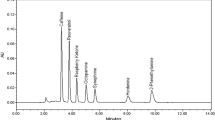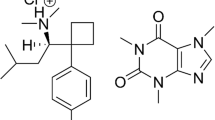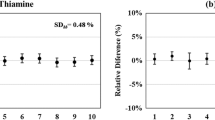Abstract
As part of a study initiating the development of an analytically validated Dietary Supplement Ingredient Database (DSID) in the United States (US), a selection of dietary supplement products were analyzed for their caffeine content. Products sold as tablets, caplets, or capsules and listing at least one caffeine-containing ingredient (including botanicals such as guarana, yerba mate, kola nut, and green tea extract) on the label were selected for analysis based on market share information. Two or three lots of each product were purchased and analyzed using high-pressure liquid chromatography (HPLC). Each analytical run included one or two National Institute of Standards and Technology (NIST) Standard Reference Materials (SRMs) and two products in duplicate. Caffeine intake per serving and per day was calculated using the maximum recommendations on each product label. Laboratory analysis for 53 products showed product means ranging from 1 to 829 mg caffeine/day. For products with a label amount for comparison (n = 28), 89% (n = 25) of the products had analytically based caffeine levels/day of between −16% and +16% of the claimed levels. Lot-to-lot variability (n = 2 or 3) for caffeine in most products (72%) was less than 10%.



Similar content being viewed by others
References
Reid TR (2005) Nat Geogr 1/19/2005:15–32
Sondermeijer HP, VanMarle AGJ, Kamen P, Krum H (2002) Am J Cardiol 90:906–907
Hartley TR, Lovallo WR, Whitsett TL (2004) Am J Cardiol 93:1022–1026
Ashihara H, Crozier A (2001) Trends Plant Sci 6(9):407–413
US Department of Agriculture, Agricultural Research Service, Nutrient Data Laboratory (2007) Nutrient Data Laboratory home page. http://www.ars.usda.gov/ba/bhnrc/ndl. Cited 18 January 2007
US Department of Health and Human Services, Centers for Disease Control and Prevention, National Center for Health Statistics, National Health and Nutrition Examination Survey (2007) National Health and Nutrition Examination Survey home page. http://www.cdc.gov/nchs/nhanes.htm. Cited 18 January 2007
US Department of Agriculture, Agricultural Research Service, Food Surveys Research Group (2007) Food Surveys Research Group homepage. http://www.ars.usda.gov/ba/bhnrc/fsrg. Cited 18 January 2007
EC (2002) Commission Directive 2002/67/EC on the labelling of foodstuffs containing quinine, and of foodstuffs containing caffeine. Off J Eur Commun L191:20–21 (see http://europa.eu/scadplus/leg/en/lvb/l21140.htm, cited 8 June 2007)
FSANZ (2007) Australia New Zealand Food Standards code fact sheets: warning and advisory statements. http://www.foodstandards.gov.au/newsroom/factsheets/industryfactsheetsfsc/warningandadvisoryst1155.cfm. Cited 18 January 2007
US National Institute of Standards and Technology (NIST) (2006) Certificates of analysis, Standard Reference Materials (SRMs 3243 and 3244). http://ts.nist.gov/MeasurementServices/ReferenceMaterials/232.cfm. Cited 8 June 2007
Brunetta MR, Gutierrez L, Delgado Y, Gallignani M, Zambrano A, Gomez A, Ramos G, Romero C (2007) Food Chem 100:459–467
Tzanavaras PD, Themelis DG (2007) Anal Chim Acta 581:89–94
Sharma V, Gulati A, Ravindranath SD, Kumar V (2005) J Food Comp Anal 18:583–594
Wang H, Helliwell K, You X (2000) Food Chem 68:115–121
Lin YS, Wu, SS, Lin JK (2003) J Agric Food Chem 51:975–980
Yang XR, Ye CX, Xu JK, Jiang YM (2007) Food Chem 100:1132–1136
Blauch JL, Tarka SM (1983) J Food Sci 48:745–747
US Department of Health and Human Services, Centers for Disease Control and Prevention, National Center for Health Statistics (2007) National Health and Nutrition Examination Survey. http://www.cdc.gov/nchs/about/major/nhanes/datalink.htm. Cited 18 January 2007
Weckerle CS (2003) Phytochemistry 64:735–742
Durrant KL (2002) J Am Pharm Assoc 42(4):625–637
Nutrition Business Journal (2004) Sports nutrition and weight loss report. http://www.nutritionbusiness.com. Cited 29 January 2004
United States Pharmacopeial Convention, Inc. (2004) USP28-NF23 In: The official compendia of standards. United States Pharmacopeial Convention, Inc., Rockville, MD
US Department of Agriculture, Agricultural Research Service, Nutrient Data Laboratory (2007) USDA nutrient database for standard reference (Release 19). http://www.nal.usda.gov/fnic/foodcomp/search/. Cited 18 December 2006
Acknowledgement
The authors would like to thank NIST for providing SRM 3243 and SRM 3244 materials for this study.
Author information
Authors and Affiliations
Corresponding author
Rights and permissions
About this article
Cite this article
Andrews, K.W., Schweitzer, A., Zhao, C. et al. The caffeine contents of dietary supplements commonly purchased in the US: analysis of 53 products with caffeine-containing ingredients. Anal Bioanal Chem 389, 231–239 (2007). https://doi.org/10.1007/s00216-007-1437-2
Received:
Revised:
Accepted:
Published:
Issue Date:
DOI: https://doi.org/10.1007/s00216-007-1437-2




